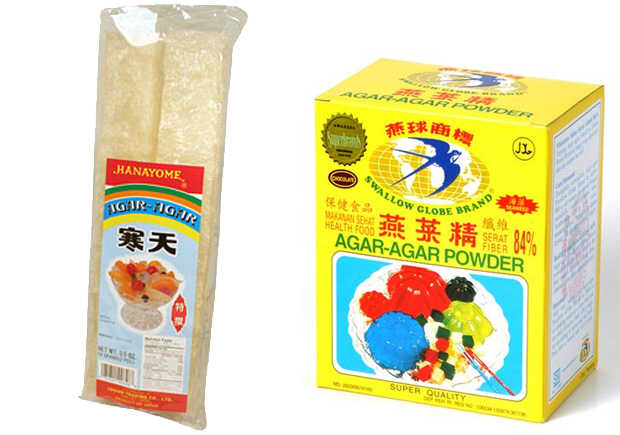
What is Agar-agar?
Agar-agar is a gelatinous substance derived from specific species of algae. It is also known as Kanten (from its Japanese derivative as agar-agar was supposedly discovered in 17th Century Japan). What allows agar-agar to have its gelling abilities is a polysaccharide from the cell walls of the algae.
Agar-agar has long been used all over Asia predominantly in desserts, to create puddings, jellos, custards and certain types of moist cakes. It is also used as a thickening agent much the same way cornstarch is used. Sold all over Asia and in Asian markets around the world, agar-agar is typically available in two forms.
The most common form is a white (sometimes off-white) powder sold in little packets. This original, plain powder form of agar-agar has no added sugar, has zero calories, is odor-free and taste-free. If used to make a simple jelly, it becomes an off-white, semi translucent color. The second most common form is in off-white dried strips (as pictured above) that kind of look like white colored seaweed due to its ripples and ridges.
The powdered form of agar-agar also comes in various colors and flavors since the commercialization of this hugely popular gelatin agent in recent decades. Not uncommon are green, red and blue agar-agar powders, typically relating to Pandan, Strawberry and some indecipherable “blue” flavor. Personally, I don’t like using those colored powders as they contain additives absent from the original and plain agar-agar powder.
Health benefits of agar-agar include being very high in fiber, calcium, potassium and iron. It has long been known to help with digestive issues and even suppress appetite for those on diets. Agar-agar is a totally vegan product- free of sugar, cholesterol, eggs, dairy, gluten, soy and starch.


 Welcome to Food, Travel & Life with The Asian Fusion Girl. Learn more about the AF Girl and her various projects
Welcome to Food, Travel & Life with The Asian Fusion Girl. Learn more about the AF Girl and her various projects




